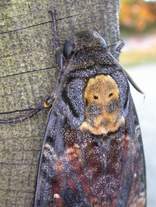 The Moth in Myth and Legend
The Moth in Myth and Legend
Due to its skull-and-crossbones markings and its unexpected ability to make quite a loud sound, the Death's Head has been an object of terror throughout the ages. Its sinister qualities are enshrined in its name:
atropos,
styx and
lachesis are all death-related. The first refers to the member of the Moirae who cuts the threads of life of all beings in Greek mythology; the second to the river of the dead, also in Greek mythology; and the last refers to the Moira who allots the correct amount of life to a being. In addition the genus name
Acherontia is derived from Acheron, a river in Greece that was believed in Greek Mythology to be a branch of the river Styx.
Throughout Europe, the moth was thought to be a harbinger of war, pestilence, and death to man and beast alike. Its appearance in a candlelit room, especially if it managed to snuff out the candle, was an omen of death in the house. In France, dust from its wings was thought to cause blindness if it entered the eye. The moth brought fear and panic in Brittany when large numbers appeared at the time of a widespread pestilence. The moth's awe-inspiring properties are markedly enhanced by the sounds it makes: these have been described as a 'dismal, melancholy cry' and like the 'plaintive squeaking of a mouse'. In Poland, where it is known as the 'wandering death-bird', its cry was heard as a voice of anguish, the moaning of a grief-stricken child.



 The Moth in Myth and Legend
The Moth in Myth and Legend

 Edited by Mythical_Geek
Edited by Mythical_Geek